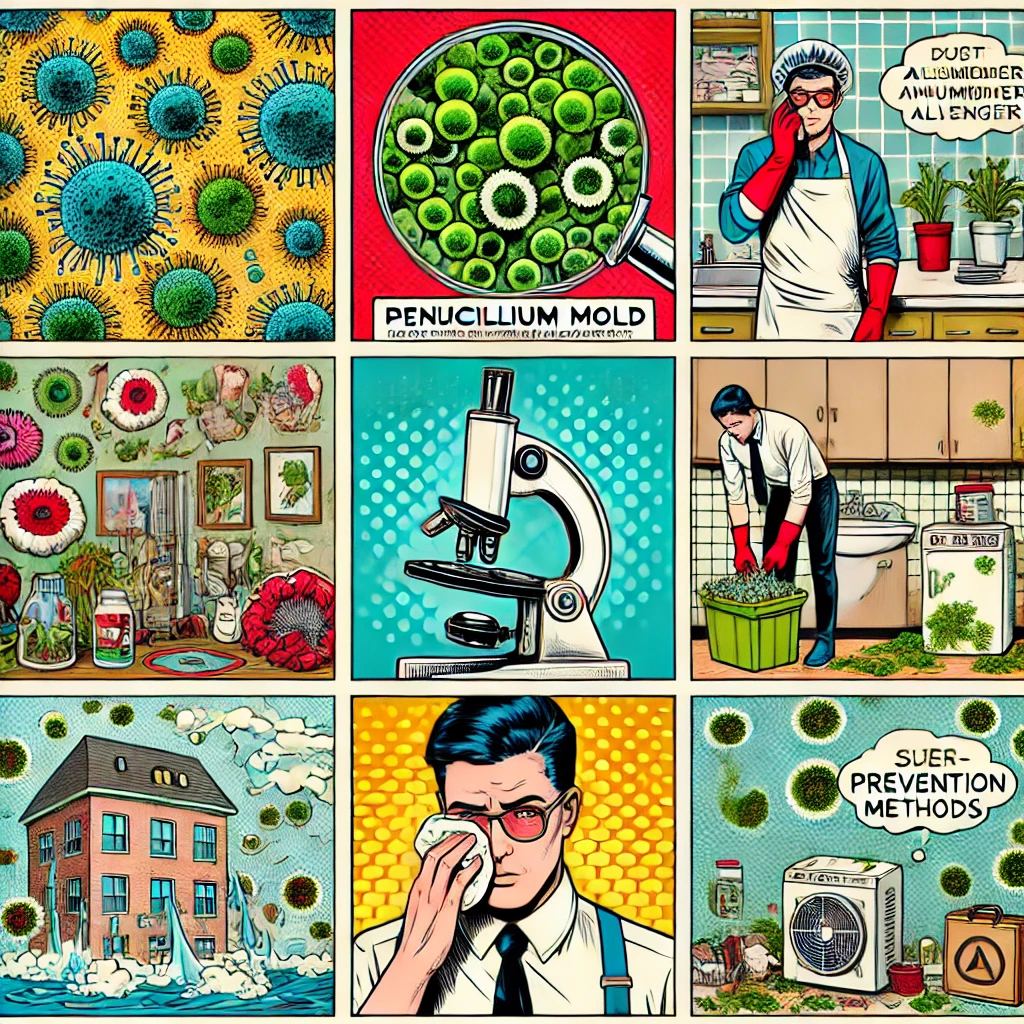Penicillium Mold
Penicillium mold is a common type of fungus found in various environments, especially indoors and in soil, decaying plant material, and food. It is part of the Penicillium genus, which includes hundreds of species. While it plays beneficial roles in nature and industry (e.g., producing antibiotics like penicillin), it can also cause problems, particularly for individuals with mold allergies or compromised health.
Characteristics of Penicillium Mold:
- Appearance: Penicillium mold typically appears as a green, blue-green, or yellowish fuzzy growth, often found on decaying food, damp walls, or other moist surfaces.
- Reproduction: It spreads through tiny spores that become airborne and are easily inhaled or deposited on surfaces.
- Environment: It thrives in damp, poorly ventilated areas, making it common in bathrooms, basements, and areas with water damage.
Allergy Effects of Penicillium Mold:
Exposure to Penicillium mold spores can trigger allergic reactions, especially in individuals sensitive to mold. The effects range from mild to severe and are similar to other mold-related allergies.
Common Allergy Symptoms:
- Respiratory Symptoms:
- Sneezing
- Runny or stuffy nose
- Coughing
- Wheezing
- Shortness of breath or chest tightness (asthma exacerbation in people with mold-triggered asthma)
- Eye and Skin Irritation:
- Itchy, red, or watery eyes
- Skin rashes or hives (less common)
- Sinus Issues:
- Sinus congestion or headaches
- Recurring sinus infections (in chronic cases)
Chronic or Severe Reactions:
- Asthma Complications: Exposure can worsen asthma symptoms, leading to severe attacks.
- Hypersensitivity Pneumonitis: In rare cases, prolonged exposure can lead to this immune-related lung condition, causing fever, fatigue, and shortness of breath.
- Mold-Induced Toxicity: Certain Penicillium species (e.g., P. chrysogenum and P. verrucosum) produce mycotoxins that, in high concentrations, can be harmful, particularly for people with weakened immune systems.
Who Is Most At Risk?
- Allergy-Prone Individuals: Those with mold allergies or hay fever are highly sensitive.
- Asthma Patients: Mold exposure can aggravate asthma symptoms.
- Immunocompromised Individuals: People with weakened immune systems (e.g., due to chemotherapy, organ transplants, or diseases like HIV) are at higher risk of fungal infections.
- Children and the Elderly: These groups are often more sensitive to airborne allergens.
Prevention & Mitigation:
- Control Humidity: Keep indoor humidity below 50% to prevent mold growth.
- Fix Leaks: Address water damage or leaks promptly.
- Ventilation: Ensure proper ventilation in bathrooms, kitchens, and basements.
- Clean Regularly: Use mold-killing cleaners in damp areas and remove any visible mold promptly.
- Use Air Purifiers: HEPA filters can help reduce airborne mold spores.
- Avoid Exposure: Wear protective masks and gloves if cleaning areas with mold.
If you suspect Penicillium mold exposure and experience persistent allergy symptoms, consult a healthcare provider or allergist. Testing and treatment options, including antihistamines, decongestants, or immunotherapy (allergy shots), can help manage the effects.
